
Filippo Juvarra
Encyclopedia
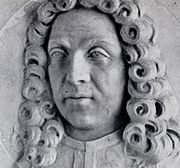
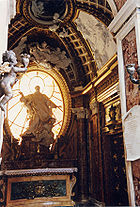
Italy
Italy , officially the Italian Republic languages]] under the European Charter for Regional or Minority Languages. In each of these, Italy's official name is as follows:;;;;;;;;), is a unitary parliamentary republic in South-Central Europe. To the north it borders France, Switzerland, Austria and...
architect
Architect
An architect is a person trained in the planning, design and oversight of the construction of buildings. To practice architecture means to offer or render services in connection with the design and construction of a building, or group of buildings and the space within the site surrounding the...
and stage set designer.
Biography
Filippo Juvarra was an Italian BaroqueBaroque
The Baroque is a period and the style that used exaggerated motion and clear, easily interpreted detail to produce drama, tension, exuberance, and grandeur in sculpture, painting, literature, dance, and music...
architect working in the early part of the eighteenth century. He was born in Messina, Sicily
Sicily
Sicily is a region of Italy, and is the largest island in the Mediterranean Sea. Along with the surrounding minor islands, it constitutes an autonomous region of Italy, the Regione Autonoma Siciliana Sicily has a rich and unique culture, especially with regard to the arts, music, literature,...
, to a family of goldsmiths and engravers. After spending his formative years with his family in Sicily where he designed Messina's festive settings for the coronation of Philip V of Spain and Sicily
Philip V of Spain
Philip V was King of Spain from 15 November 1700 to 15 January 1724, when he abdicated in favor of his son Louis, and from 6 September 1724, when he assumed the throne again upon his son's death, to his death.Before his reign, Philip occupied an exalted place in the royal family of France as a...
(1705), Juvarra moved to Rome
Rome
Rome is the capital of Italy and the country's largest and most populated city and comune, with over 2.7 million residents in . The city is located in the central-western portion of the Italian Peninsula, on the Tiber River within the Lazio region of Italy.Rome's history spans two and a half...
in 1704. There he studied architecture with Carlo
Carlo Fontana
Carlo Fontana was an Italian architect, who was in part responsible for the classicizing direction taken by Late Baroque Roman architecture.-Biography:...
and Francesco Fontana
Francesco Fontana
Francesco Fontana was an Italian lawyer and astronomer.He created woodcuts showing the Moon and the planets as he saw them through a self-constructed telescope...
.
The first phase of his independent career was occupied with designs for ceremonies and celebrations and especially with set designs for theatres. Juvarra's set designs incorporate the scena per angolo, literally 'scenes at an angle.' The exact origin of this style is unclear. Ferdinando Galli Bibiena claims to have invented it in his treatise Architettura Civile (1711), however, it was clearly in use before then, including in the works of Juvarra. This style differed from the one point perspective sets that had been developed in the sixteenth century, and had reached their apogee in the seventeenth century, see for example the work of Giacomo Torelli
Giacomo Torelli
Giacomo Torelli was the most important set designer of the middle of the seventeenth century. Born in 1608 in the town of Fano, the year of Giulio Parigi’s work on Il Giudizio di Paride in Florence, Torelli was of noble birth. His work in stage design was extensively engraved and hence survives...
. A couple of early drawings dated 1706 are associated with the Teatro S. Bartolomeo, Naples
Naples
Naples is a city in Southern Italy, situated on the country's west coast by the Gulf of Naples. Lying between two notable volcanic regions, Mount Vesuvius and the Phlegraean Fields, it is the capital of the region of Campania and of the province of Naples...
(1706), though whether he actually completed set designs for the theatre is unknown. The majority of his work in theatre and set design was in Rome under the patronage of Cardinal Ottoboni. He assisted in the rebuilding of the Cardinal's private theatre in the Palazzo della Cancelleria
Palazzo della Cancelleria
The Palazzo della Cancelleria is a Renaissance palace in Rome, Italy, situated between the present Corso Vittorio Emanuele II and the Campo de' Fiori, in the rione of Parione...
and also designed sets for operas performed within the theatre. The first opera for which Juvarra designed all the sets was Costantino Pio. The libretto was by Cardinal Ottoboni and the music was by Carlo Francesco Pollarolli (c.1653 – 1723). It was premiered in 1709 and was one of the first operas to appear after the lifting of papal bans on secular theatre, it also inaugurated Ottoboni’s newly renovated private theatre. He also worked on set designs for performances sponsored by Ottoboni at the Teatro Capranica. His other main patron in Rome was Queen Maria Casimira, the widowed Queen of Poland, for whom Juvarra produced set designs for the operas held in her small domestic theatre in the Palazzo Zuccari. In 1713 a theatre project took him to Genoa
Genoa
Genoa |Ligurian]] Zena ; Latin and, archaically, English Genua) is a city and an important seaport in northern Italy, the capital of the Province of Genoa and of the region of Liguria....
.
In 1706 Juvarra won a contest for the new sacristy at the St. Peter's, organized by Pope Clement XI
Pope Clement XI
Pope Clement XI , born Giovanni Francesco Albani, was Pope from 1700 until his death in 1721.-Early life:...
, and became a member of the prestigious Accademia di San Luca
Accademia di San Luca
The Accademia di San Luca, was founded in 1577 as an association of artists in Rome, under the directorship of Federico Zuccari, with the purpose of elevating the work of "artists", which included painters, sculptors and architects, above that of mere craftsmen. Other founders included Girolamo...
. In 1708 he created his first important non-theatrical architectural work, and the only one realized in Rome: the small but superbly executed Antamoro Chapel in the church of San Girolamo della Carità
San Girolamo della Carità
San Girolamo della Carità is a church in Rome, Italy, located near the Palazzo Farnese and Campo de' Fiori.The church belonged originally to the Franciscan Observants. In 1524 it was taken over by the Archconfraternita della Carità, founded by Giulio de' Medici in 1519; a society of noblemen from...
which he conceived in intimate cooperation with his close friend, the French sculptor Pierre Le Gros
Pierre Le Gros the Younger
Pierre Le Gros was a French sculptor, active almost exclusively in Baroque Rome. Nowadays, his name is commonly written Legros, while he himself always signed as Le Gros; he is frequently referred to either as 'the Younger' or 'Pierre II' to distinguish him from his father, Pierre Le Gros the...
, who was responsible for carrying out the sculptural components.
Juvarra was also an engraver: his book of engravings of sculpted coats-of-arms appeared in 1711, Raccolta di varie targhe fatte da professori primarii di Roma http://members.tripod.com/romeartlover/Juvarra.html.
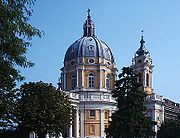
Piedmont
Piedmont is one of the 20 regions of Italy. It has an area of 25,402 square kilometres and a population of about 4.4 million. The capital of Piedmont is Turin. The main local language is Piedmontese. Occitan is also spoken by a minority in the Occitan Valleys situated in the Provinces of...
where Victor Amadeus II of Savoy
Savoy
Savoy is a region of France. It comprises roughly the territory of the Western Alps situated between Lake Geneva in the north and Monaco and the Mediterranean coast in the south....
first employed him in a scenographic project, then elevated Juvarra to the position of the first architect of the court. The fame obtained here led to demand for his talent and capacities at some of the richest noble and royal courts of Europe
Europe
Europe is, by convention, one of the world's seven continents. Comprising the westernmost peninsula of Eurasia, Europe is generally 'divided' from Asia to its east by the watershed divides of the Ural and Caucasus Mountains, the Ural River, the Caspian and Black Seas, and the waterways connecting...
: in 1719 he was in Portugal
Portugal
Portugal , officially the Portuguese Republic is a country situated in southwestern Europe on the Iberian Peninsula. Portugal is the westernmost country of Europe, and is bordered by the Atlantic Ocean to the West and South and by Spain to the North and East. The Atlantic archipelagos of the...
, planning the palace at Mafra
Mafra National Palace
The Mafra National Palace is a monumental Baroque and Italianized Neoclassical palace-monastery located in Mafra, Portugal, some 28 kilometres from Lisbon. Its dimensions are so huge that it dwarfs the city...
for King John V (1719–20), after which he travelled to London and Paris.
Among his numerous works and projects in Turin are:
- Basilica di Superga (1715-1718) built on the high hill over TurinTurinTurin is a city and major business and cultural centre in northern Italy, capital of the Piedmont region, located mainly on the left bank of the Po River and surrounded by the Alpine arch. The population of the city proper is 909,193 while the population of the urban area is estimated by Eurostat...
; - Facade of the church of Santa Cristina (1715-1718);
- Basilica della Natività
- Palazzo Madama in Turin
- Third enlargement of Turin to the west according to the orthogonal system introduced by Ascanio VitozziAscanio VitozziAscanio Vitozzi was an Italian soldier, architect and military engineer....
and Carlo di CastellamonteCarlo di CastellamonteCarlo di Castellamonte was an Italian architect, civil and military engineer, one of the main exponents of Piedmontese Baroque.Castellamonte was born in Turin. After his studies in Rome, he returned in Piedmont where was assistant to Ascanio Vitozzi...
: the project included construction of Palazzo Martini di Cigala (1716), of the Quartieri Militari (1716-1728) and later of the church del Carmine (1732-1736), where the space is concentrated around the central hall with the scenographic effect of light falling from above.
Drawing upon Italian and French architectural traditions, Juvarra designed the facade and grand theatrical ceremonial entrance staircase of the Palazzo Madama in Turin (1718-1721). For the Savoy royal family, he built and decorated the hunting lodge called the Palazzina di Stupinigi (1729–1731). Juvarra and Johann Fischer von Erlach
Johann Bernhard Fischer von Erlach
----Johann Bernhard Fischer von Erlach, born Johann Bernhard Fischer was probably the most influential Austrian architect of the Baroque period....
influenced one another through the medium of engravings.
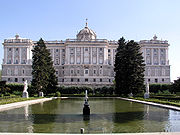
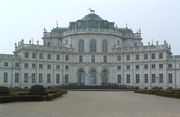
Philip V of Spain
Philip V was King of Spain from 15 November 1700 to 15 January 1724, when he abdicated in favor of his son Louis, and from 6 September 1724, when he assumed the throne again upon his son's death, to his death.Before his reign, Philip occupied an exalted place in the royal family of France as a...
, for whom he executed the projects for the Royal Palace
Royal Palace of Madrid
The Palacio Real de Madrid is the official residence of the King of Spain in the city of Madrid, but it is only used for state ceremonies. King Juan Carlos and the Royal Family do not reside in the palace, choosing instead the more modest Palacio de la Zarzuela on the outskirts of Madrid...
, Granja de San Ildefonso
La Granja (palace)
The Royal Palace of La Granja de San Ildefonso is an 18th century palace in the small town of San Ildefonso in the hills near Segovia, 80 km north of Madrid, central Spain, formerly the summer residence of the Kings of Spain since the reign of Philip V...
and Palacio Real de Aranjuez
Palacio Real de Aranjuez
The Royal Palace of Aranjuez is a residence of the King of Spain, located in the town of Aranjuez, Community of Madrid, Spain. The palace is open to the public as one of the Spanish royal sites....
, executed after the death of Juvarra by Giovanni Battista Sacchetti and other pupils. Another Baroque architect strongly influenced by Juvarra was Bernardo Vittone
Bernardo Vittone
Bernardo Antonio Vittone was an Italian architect and writer. He was one of the three most important Baroque architects active in the Piedmont region of Northern Italy; the other two were Filippo Juvarra and Guarino Guarini. The youngest of the three, Vittone was the only one who was born in the...
who practised architecture in Piedmont
Piedmont
Piedmont is one of the 20 regions of Italy. It has an area of 25,402 square kilometres and a population of about 4.4 million. The capital of Piedmont is Turin. The main local language is Piedmontese. Occitan is also spoken by a minority in the Occitan Valleys situated in the Provinces of...
.
Juvarra died in Madrid in 1736. His work, along with much of Baroque
Baroque
The Baroque is a period and the style that used exaggerated motion and clear, easily interpreted detail to produce drama, tension, exuberance, and grandeur in sculpture, painting, literature, dance, and music...
architecture, fell out of favour with the rise of Neoclassicism
Neoclassicism
Neoclassicism is the name given to Western movements in the decorative and visual arts, literature, theatre, music, and architecture that draw inspiration from the "classical" art and culture of Ancient Greece or Ancient Rome...
.
In 1994, a major exhibition of his designs was held in Genoa and Madrid.

